Category: Blog
With only one month left in 2019, it’s time to celebrate Nerd Nites past. Join us for our 3rd annual Solstice Spectacular – a night of shenanigans, sasquatch and science! We’ve invited all of 2019’s Nerd Nite speakers to join us and we’re hoping you’ll join in too! Come and mingle, grab a drink, and watch past speakers and audience members play “Powerpoint Karaoke,” where presenters are given 5 minutes to present using a slide deck they haven’t seen before. Want to play? Put your name in a hat to present and win prizes! And true to Nerd Nite tradition, this Solstice will feature special guest speaker Jay Ingram (host of Discovery Channel’s ‘Daily Planet’, CBC’s ‘Quirks and Quarks’, and author of the book series ‘The Science of Why?) who will be delving into the complex science of the impacts of climate change on the sasquatch. THESE ARE THE BIG QUESTIONS EVERYONE!
Hosted by: Kaylee Byers and Michael Unger
When: Wednesday December 18th; Doors @ 7, show starts @ 7:30
Poster by: Armin Mortazavi
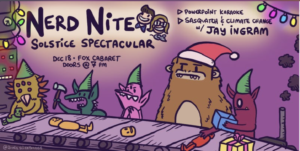
Hold onto your butts everyone because we’re back with a stellar lineup of talks about dinosaur dentition, post-prison consultation, and lake sonar mapping on November 20th. Fun fact: on this same day in 1889, Edwin Hubble was born. Hubble contributed to the Hubble-Lamaitre Law that implies that the universe is expanding (EXPANDING INTO WHAT screams Kaylee) and discovered that all those clouds of space dust were actually galaxies past the Milky Way. And while Hubble has a NASA telescope named after him, and his birthdate is listed in “Celebrity Birthdays on November 20th”, someone who receives far less attention (and who is not famously known as an asshole) is Henrietta Leavitt. Leavitt has been described as “the woman who gave us a universal ruler” and whose work was foundational to Hubble’s discovery of galaxies. While working as one of many data-crunching “computers” at Harvard University, she also used star brightness and variability of that brightness to determine a star’s distance from earth. It’s her observation and calculations which allowed us to convert our view of the night sky from 2D to 3D. So, this Nerd Nite, let’s raise a glass (or two) to a woman whose work was largely overlooked, learn about other novel work being done across disciplines, and take an extra moment or two to look up at the stars.
Hosted by: Kaylee Byers and Michael Unger
When: Wednesday November 20th; Doors @ 7, show starts @ 7:30
Poster by: Armin Mortazavi
Music by: DJ Birthday
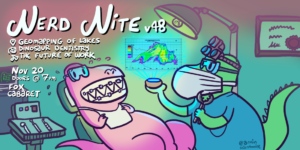
Beyond the Shallows: Bathymetric Mapping in the Sea to Sky
Dr. Steve Quane
When visiting some of the most spectacular places in the Sea to Sky region, modern Instagram culture tends to both figuratively and literally stop near the water’s edge. The local, blue and green glacial lakes are transfixing in their surficial beauty, inviting thought and contemplation about the natural spaces they comprise. Nonetheless, many hikers at these magical geological places find themselves battling overcrowded parking lots and hiking many kilometers on overwhelmed, trash-littered trails, only to snap a picture on an over-photographed log before scurrying back to phone service to hit “share” on their post-worthy adventure. Certainly, these lakes must posses something deeper and more meaningful beneath the surface? I will present my work on sonar mapping the bathymetry of a few local celebrity lakes and perhaps over-pontificate on whether a deeper understanding of the natural world can help us curate a local landscape under siege.
Bio: Steve has a PhD from the University of British Columbia where he studied experimental volcanology. After a three-year teaching gig at Colorado College, Steve washed up as a Geology Professor at Quest University in Squamish. An avid volcano enthusiast, Steve has been researching the formation of and resulting natural hazards created by the stunning glacio-volcanic landscapes in the Sea to Sky region. He is also a founding member of the Sea to Sky Fire and Ice GeoPark Steering Committee. Steve will likely be the only local running the trails towards, and skiing the slopes of, Mt. Garibaldi during its next eruption.
Dinosaur Dentistry
Dr. Kirsten Brink
One of the most impressive features of dinosaurs are their vicious-looking teeth. In this presentation, Kirstin blends together her knowledge of the fossil record of dinosaurs and her current research in dentistry to address the age-old question: Did dinosaurs get dental cavities? Join her on a journey to understand how we interpret dinosaur diets from fossil remains, how dinosaur teeth compare to human teeth, and the importance of flossing.
Bio: Kirstin received her PhD in vertebrate palaeontology from the University of Toronto. She is currently working as a Banting Postdoctoral Fellow in the Faculty of Dentistry at UBC, studying the evolution and development of lizard teeth. When not in the lab, you can find Kirstin holding a glass of wine or holding binoculars and staring at birds.
Experts Behind Bars: What Former Prisoners Can Teach Us About the Future of Work
Dr. Ray Hsu
When I first learned about former prisoners becoming consultants for white collar criminals who were entering prison, I had been teaching writing in prisons for the better part of three years. I was also on the verge of becoming a professor and I was already having doubt about the role of the university in a grander scheme of things. And I wasn’t alone: on online communities where academics gathered, I was noticing people abuzz about consulting as a path beyond academia. As more and more people flee the constraints of organizations–academic, corporate, institutional–the more the ranks of “consultants” grow.
In this talk, I argue that “consulting” is an emergent and rapidly growing category that is both legible and within reach for conceptual weaponization against the prison–university–industrial complex. What, I ask, can post-prison consulting teach us about the nature of expert knowledge labour beyond institutions and the potential for a class consciousness that is both enabled by capitalism and, potentially, aimed to “disrupt” it?
Bio: Dr. Ray Hsu is cofounder of Foxlab (foxlab.ca), where empowers consultants to build out their expertise into expert businesses. He is also author of two award-winning books of poetry and served as Faculty Supervisor of the UBC Emerging Media Lab, where he worked on virtual reality, augmented reality and mixed reality. He has taught creative practice at the Banff Centre, SFU’s The Writers Studio, UBC’s Creative Writing program, as well as in a United States prison, where he taught for the better part of three years.
Fall is upon us. It’s time to bust out your hipster beanie, wait extra-long in a coffee line while everyone orders a pumpkin spiced latte, and crunch through the fallen leaves while wondering: what’s up with these leaves changing colour? It turns out that colour change is driven by less daylight. The green pigment chlorophyll, which starts the process of photosynthesis, breaks down. In the summer chlorophyll is replenished, but in the fall the veins bringing water and nutrients to the leaves close off and so when the chlorophyll breaks down and isn’t regenerated, the green pigments fade. This allows the yellow and orange pigments that were already in the leaf to become the stars of the show. But wait… what about the reds? Unlike the orange and yellow pigments, the red pigments form during the fall. With the closing of the veins, the sugars that are normally transferred from leaf to tree branches get trapped in the leaf. These sugars react with other chemicals to form red pigments – more sugars trapped in the leaves = brighter reds! So while leaves change colour and then peace-out with less daylight, at Nerd Nite we’re embracing those cooling fall nights with another line up of amazing speakers who will teach us about neuroscience, overcoming stigma around crystal meth use, and queer storytelling.
When: Wednesday October 16th; Doors @ 7, show starts @ 7:30
Co-Hosted by: Michael Unger
Special guest host: Shanda Leer
Poster by: Armin Mortazavi
DJ: Grant Francis Minor – DJ Burger
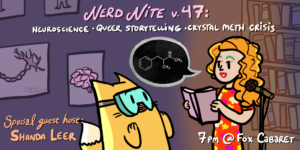
1. The Struggles of Being a Socially Awkward Adolescent Rat
Travis Hodges
Social experiences are very important during adolescence, such that disrupting those experiences results in lasting changes in social behaviour and in specific brain regions. Compared to other age groups, the adolescent brain is also the most susceptible to social stressors. In adolescent rats, I altered their social experiences by changing their cage partners every day for a little over two weeks (similar to moving a child to a new school several times or through foster homes several times during adolescence) and this resulted in the rats becoming socially awkward with their adolescent peers and then with their adult peers when they became adults. I will talk about why rats are cute, the similarities between adolescent rats and adolescent humans, how socially awkward behaviours caused by stress in adolescence manifest in adulthood, and what systems in the brain are involved in social awkwardness. Our past social experiences have already molded how we act as adults, but hopefully these findings will stress the importance of providing coping strategies to current and future adolescents in stressful social situations.
Bio: Travis received a PhD in Psychology with training in Behavioural Neuroscience from Brock University in St. Catharines, Ontario. Travis now works as a postdoctoral fellow in the lab of Dr. Liisa Galea at the Djavad Mowafaghian Centre for Brain Health at UBC. Travis’s research projects have always focused on the sex-specific impact of stress on the brain from early-life to adulthood. A main focus of his PhD was determining what changes in the brain result in social awkwardness after social stress in adolescence and in a rat model. Travis’s research at UBC focuses on the brain regions involved in negative cognitive biases or pessimism, and how stress and altering the amount of new born neurons in the brain affect negative cognitive biases in males vs. females and in adolescents vs. adults using rodent models. Travis is a member of the Women’s Health Research Cluster (WHRC) and a committee member of the Cluster’s Trainee Presentation series. The WHRC Trainee Presentation Series aims to get young researchers to present research that focuses on women’s health and form connections with other researchers and the rest of the community. When he is not in the lab, Travis is a huge fan of watching horrible movies, singing at karaoke, and dancing away life’s stressors.
2. From Forest Nymph to Limp Wrist: The Art of Queer Storytelling
David Cutting
Enjoy this weird and wonderful presentation that explores the genesis of queer identity through embracing pop culture and, hopefully, inspires you to seek out and absorb your queer friends’ own stories.
Bio: David Cutting is a local drag performer, producer and creative. Their Drag persona Dust can be caught hosting Commercial Drag, a Bi weekly drag show and Yuk it up Sis a monthlyish Drag Comedy Show at Yuk Yuks Comedy Club.
You can follow David at @unicornriverchild
3. Let’s Talk About Vancouver’s Crystal Meth Crisis
Lisa Allyn
When I say “there’s a drug crisis in Vancouver,” does crystal meth come to mind? I’ve come to realize that few people outside the bubble of healthcare, social services, and law enforcement appreciate the extent and urgency of the gigantic decade-long crystal meth crisis in our city. It’s fascinating and shocking. Why aren’t we urgently working on solutions to a huge problem that for a decade has been in plain sight, has ended and damaged countless lives, and drains our limited public resources? Let’s start breaking bad habits – it’s time to talk openly about Meth. Is it really blue? Why do users use it? What are the impacts & scale of the crisis? How does meth use relate to trauma, shame, stigma and wealth inequality? We’ll go over concrete steps we can all take toward healing the devastations of crystal meth use in our communities, including practical tips for being better neighbours and allies.
Bio: Lisa Allyn is a brain, behaviour, and trauma nerd who works in rehabilitation and recovery with substance users in Downtown Vancouver. She is trained as an occupational therapist. OTs specialize in providing interventions (tools, strategies, equipment, supports) for all kinds of functional deficits (eg. challenges putting on clothing, writing a budget, driving a car, playing hockey).
Back to school nerds! We can’t wait to hear what you have all been up to this summer, we hope that you’ve joined us for our summer movie vacation at VIFF. Kaylee and Michael went to Banff for the Science Communication program and are amped up to get back to what we love doing: drinking and learning. Message us or tweet at us @nerdniteyvr and tell us what nerdy things you’ve been up to this summer, we’ll talk about them on the 18th!
When: Wednesday September 18th; Doors @ 7, show starts @ 7:30
Hosted by: Kaylee Byers and Michael Unger
DJ: Courtenay Webber
Poster: Armin Mortazavi
IG: @armin.scientoonist
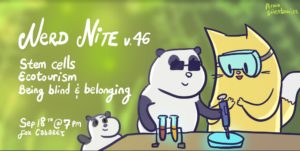
1. Should I swim with that whale shark?
Josh Silberg
From Mexico to Australia to Southeast Asia, whale shark tourism has exploded around the world in the last decade. Tourists are generally brought to swim with the world’s largest fish at places where they aggregate in large numbers. Unfortunately, wild animals don’t always get the memo, so sometimes people can go home without seeing a shark. In the central Philippines, one town has figured out how to pretty much guarantee you see whale sharks—they feed them. Feeding wildlife for ecotourism purposes is controversial, and even shark conservationists differ in opinions. How can we ensure whale shark tourism is sustainable for both the sharks and the people who rely on tourism for their livelihoods?
Bio: Josh Silberg has researched everything from humpback whales to whale sharks to rockfish—he just couldn’t decide on one creature to study. After earning a Master’s of Resource and Environmental Management from Simon Fraser University, he joined the British Columbia-based Hakai Institute as the Science Communications Coordinator. Now, he gets to share all sorts of coastal science stories through blogs, videos, graphics, and the occasional poem. Josh is also a Vancouver producer with The Story Collider, and hosts four shows per year where people perform true, personal stories about science. In his free time, he can be found photographing wildlife, hiking, or searching for creatures in tide pools. You can follow him on twitter @joshsilberg.
2. Being Blind and Belonging
Laura Yvonne Bulk
Bio: Laura Yvonne Bulk (@LYBOT) is a teacher, advocate, friend, learner, woman, disabled person, occupational therapist, Christian, activist, and scholar. Her work focuses on enhancing diversity and understanding and promoting human dignity and flourishing. Laura aims to benefit the wider community and the academic and clinical communities through collaboration, creativity, and evidence-based approaches.
3. Decellularization: Using Nature’s Scaffolding to Build Tissue
Alison Müller
Some of the most exciting medical technology is focused around building new, healthy tissue using a patient’s cells. The dream goal is to create a 3D organ that can completely replace a damaged or diseased one. There are a few techniques that are being used to make this a reality, and one of the most exciting ways involves utilizing what’s naturally already available. It is a three-dimensional structure called the extracellular matrix made up of different proteins that create a scaffold for cells to live in. Without this scaffolding, we would just be a mush of cells, similar to Ditto. Scientists are using this naturally available shape to better understand how this structure determines cell fate and if it is possible to completely rebuild organs using cells and nature’s scaffolding.
Bio: Alison Muller is a PhD graduate from the University of Alberta who has recently moved back home to Vancouver. She loves presenting cutting edge medical research and has had panels at numerous Comic Expos discussing science fiction inspired technology. She has been a guest on CBC Radio morning shows in Edmonton and Calgary as well as appearing on Global Edmonton participating in a liquid nitrogen explosion, all to promote her Comic Expo science panels. She recently founded aliscience.ca, a science communication blog that publishes different topics focused around medical science discoveries as well as the tools used in the research field. She’s looking forward to starting her biotech career here.
Our final episode in VIFF and Nerd Nite’s summer movie series takes us into the world of genetics with Dr. Greg Bole who teaches Evolution, Ecology, and Genetics at the University of British Columbia! Tonight he’ll join Michael from Nerd Nite and special guest host Dr. Carin Bondar to discuss the sci-facts in a variety of clips from movies about genetics and evolution!. We’ll be discussing the science of classics like Gattaca and Jurassic Park, but also more recent films like Annihilation.
When: Aug 28
When: 7:30 – 9:00 – This talk will be followed by a screening of Errol Morris’ “Gattaca” at 9:30 pm. Double bill price: $20
Tickets: Here
VIFF and Nerd Nite’s movie series is back! This time we’ll focus on disaster and apocalyptic themes with geophysicist, disaster researcher, and sci-fi scientist Mika McKinnon. Tonight she’ll join Kaylee and Michael from Nerd Nite to discuss the sci-facts in a variety of clips from movies that cover topics from a variety doomsday scenarios. We’ll be discussing the science of movies like Mad Max, The Day After Tomorrow, and Sharknado!? Buckle up.
When: Aug 14
When: 7:30 – 9:00 – This talk will be followed by a screening of Errol Morris’ “A Brief History of Time” at 9:30 pm. Double bill price: $20
Tickets: Here
SciFact vs. SciFi: Nerd Nite Goes to the Movies. “The Universe According to Hollywood.” Presented by Dr. Douglas Scott. This evening we blast off into space with astrophysicist Dr. Douglas Scott from the University of British Columbia who specializes in cosmology. Dr Scott joins Kaylee and Michael from Nerd Nite to discuss the sci-facts in a variety of clips from movies set in outer space. We’ll be discussing the science of classics like Star Wars and Star Trek, but also modern films like Interstellar and more.
When: July 31
When: 7:30 – 9:00 – This talk will be followed by a screening of Errol Morris’ “A Brief History of Time” at 9:30 pm. Double bill price: $20
Tickets: Here
This summer we’re trying something a little different. Our new summer series of talks – a collaboration between Nerd Nite and VIFF – examines the pseudo-science propagated by Hollywood, and seeks to sift real insights from fake facts, in a fun, playful but peer-approved format. Each show will feature clips from a variety of movies on a science theme with a featured scientist on hand all doneNerd Nite style with drinks! We begin with biology, and our first presenter is Dr Carin Bondar.
Dr Bondar has been the host of Science Channel’s Outrageous Acts of Science, and she’s the author of several books including “Wild Moms: The Science Behind Mating in the Animal Kingdom”. Tonight she’ll join Kaylee and Michael from Nerd Nite to discuss the sci-facts in a variety of clips from cinema. We’ll be discussing the science in Planet of the Apes, The Birds, Arachnophobia, Snakes on a Plane, and more!
When: July 10
When: 7:30 – 8:30 – This talk will be followed by a screening of Alfred Hitchcock’s classic The Birds (9pm). Double bill price: $20
Tickets: Here!
As the Earth nears its complete tilt towards the Sun, we are also halfway through what has quickly become Nerd Nite’s biggest year in Vancouver. We can’t thank you enough for helping us grow this community of adult learning, and we’ll be announcing our fun new summer movie series very soon, but for now we have some important nerding to do. June 19th is not only the anniversary of the first woman in space, Valentina Tereshkova, but also it’s National Cocktail day. In 1806 the very first definition read as follows “Cock-tail is a stimulating liquor, composed of spirits of any kind, sugar, water, and bitters—it is vulgarly called bittered sling, and is supposed to be an excellent electioneering potion, in as much as it renders the heart stout and bold, at the same time that it fuddles the head.”
Let’s fuddle the head with knowledge and potions!
When: Wednesday June 19th; Doors @ 7, show starts @ 7:30
Hosted by: Kaylee Byers and Michael Unger
DJ Bürger – Grant Francis Minor
Poster: Armin Mortazavi
IG: @armin.scientoonist
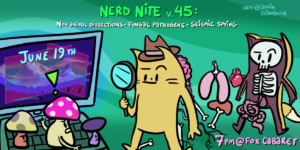
1. Non-Animal Dissections
Dr. Elisabeth Ormandy
Bio: Dr. Elisabeth Ormandy is a former neuroscientist who has spent her career getting to know animals better, on their terms. After retraining in animal behaviour, welfare, and ethics she now uses her science savvy to advocate for the advancement of science without suffering. Elisabeth is co-founder and executive director of the Animals in Science Policy Institute (AiSPI), a Vancouver-based national charity. She is an instructor at the University of British Columbia, an Advisor to both the Canadian Centre for Alternatives to Animal Methods, and the Humane Education Coalition. She is part of the editorial team for the Alternatives to Laboratory Animals journal, and also gives national policy advice to the Canadian Council on Animal Care on a regular basis.
2. The Potential Perils of Brain Eating Fungi!
Linda Horianopulos
From leaf litter on the forest floor, to the sugars in human brains, fungi can feed on all sorts of things. The brain eating fungi have particularly intrigued researchers, leading them to speculate about the possibility of “zombie fungi”. In fact, in the insect world, it is well documented that fungi including Cordyceps infect insect hosts and control their behaviour to increase the spread of the fungal pathogens. But could they affect people in the same way? The human fungal pathogen Cryptococcus neoformans disseminates throughout the body and grows well in the brain where it finds and feeds on one of its favourite sugars. We’ll explore the world of brain eating fungi and speculate on whether a human mind control fungus could reasonably evolve.
Bio: Linda is a PhD candidate with a fascination for fungi! Mushrooms are cool, but the underappreciated fungal pathogens are what really get her excited. She keeps a ukulele in the lab to pass the time and a soccer ball under her desk to hone her foot skills, after all it’s all about work-life balance, right?
3. Seismic Spying: You Can’t Keep Secrets from Rocks
Mika McKinnon
Seismology isn’t just for earthquakes. Geophysicists use seismic signals to spy on everything from bomb tests and traffic jams to crashing waves and lover’s lanes. A signal is just the noise you’re looking for, and our planet is humming in its eagerness to spill subsurface secrets.
Bio: Mika McKinnon is a geophysicist, disaster researcher, and scifi scientist. As your friendly neighbourhood geoscientist, when she’s not creeping on seismic signals, she offers tasting notes on rocks, tweaks party planning to enhance disaster preparedness, and obsesses over impending doom. McKinnon scrawls equations and establishes plausibility for shows including Stargate, Star Trek, and [redacted]. Her writing appears in Wired, io9, Vox, and more. She shares her press passes (and social media) with a bevy of mischievous plush creatures.
May 22nd is National Goth Day. The Goths’ reputation as barbarians is mostly fake news that got told from the perspective of the ego-torn Romans who got their ass handed to them in 410 CE. For the most part Goths were peaceful hunters and farmers who were very sophisticated when it came to trade, diplomacy, and agriculture. It’s no wonder that these outcasts would become the inspiration for your Gr.9 self, when perhaps you first heard the dulcet tones of Robert Smith tell you that it was okay for boys to cry, practiced your spastic Ian Curtis dance moves in the mirror, and wore eyeliner just like Siouxie. So pull your black leathers and lace and get in here for the 44th version of Nerd Nite, where we have three amazing nerds to talk about genetics, poetry, and artificial intelligence!
Hosted by: Kaylee Byers and Michael Unger
DJ Bürger – Grant Francis Minor
Poster: Armin Mortazavi
IG: @armin.scientoonist
When: Wednesday May 22nd; Doors @ 7, show starts @ 7:30
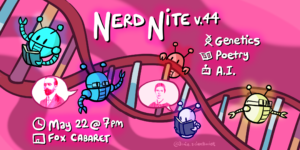
1. Can Artificial Intelligence Learn Chemistry/Physics?
Rodrigo A. Vargas–Hernández
Machine learning (ML) algorithms are used extensively in daily tasks such as language translation, image recognition, and navigation systems to mention a few. In this talk, I will explore how the fields of chemistry and physics have benefited from the use of ML algorithms. ML is divided into three main fields, (i) supervised learning, (ii) unsupervised learning and (iii) reinforcement learning. During the talk, I will explain how one can reformulate some chemistry/physics problems in terms of each field of ML. The results I will present illustrate how ML can help us predict material properties, similarities between chemicals and new synthetic routes, and the synthesis of chemical compounds without human intervention using robots and computers.
2. Poetry is Fucking Fun
Dina Del Bucchia
The worst part of being a poet, and being someone who enjoys poetry, is all the jerks who say they aren’t interested in poetry, don’t read poetry, just don’t get poetry. What everyone who limits their exposure to poetry is doing to themselves is making sure they’re having a less good time. In fact, poetry is very similar to actual popular art forms. Performed on stage poetry can be as hilarious and engaging as a night at a comedy club. On the page it has the capacity to go deep on subjects normally reserved for op-eds. Or to talk about human emotions we see reflected on TV and film. The musicality of a hit song is present in poetry’s rhythm and meter. See? It’s really not so different from other pop culture. Converting people into poetry readers is the only conversion therapy I support.
Bio: Dina Del Bucchia is an otter and dress enthusiast originally from the village of Fruitvale, BC. She is the author of the short story collection, Don’t Tell Me What to Do, and four collections of poetry: Coping with Emotions and Otters, Blind Items, Rom Com, written with Daniel Zomparelli, and the newly released, It’s a Big Deal! She is a senior editor of Poetry Is Dead magazine, the Artistic Director of the Real Vancouver Writers’ Series and hosts the pretty literary podcast, Can’t Lit, with Jen Sookfong Lee. You can find out more about her at: dinadelbucchia.com.
3. Genetics
Avery Noonan
From new ideas to recounting history, language enables us to externalize our thoughts and share our ideas with the world. With the familiar characters “ATCG” and the resemblance of a code with rules and syntax, it is easy to think of our DNA as the language of life. However, instead of being used to communicate our ideas and thoughts, the language of DNA encodes our biological past, present, and future. In an era where you can order a kit online to sequence parts of your genome and synthesize a gene for the price of a taxi home to the suburbs, reading and writing the language of life has become a common practice in medicine, agriculture, manufacturing, environmental monitoring and the study of the natural world. However, unlike the language you speak with your friends, humanity didn’t invent DNA to represent our own thoughts, and we are still working on understanding its intricacies. Much like copying out the characters of a language you don’t speak, context is everything and meaning is often lost in translation. We are going to explore the extent to which we can read and write the genetic code, and the challenges of speaking a language we are only beginning to understand.
Bio: Avery Noonan is a Toronto-born, BC-raised graduate student at the University of British Columbia. He is interested in biking, hipster cocktail bars, beach volleyball, hip hop and the engineering of microbial metabolisms to build, breakdown and detect material in an environmentally sustainable way, and the development of genetic tools for these purposes.





